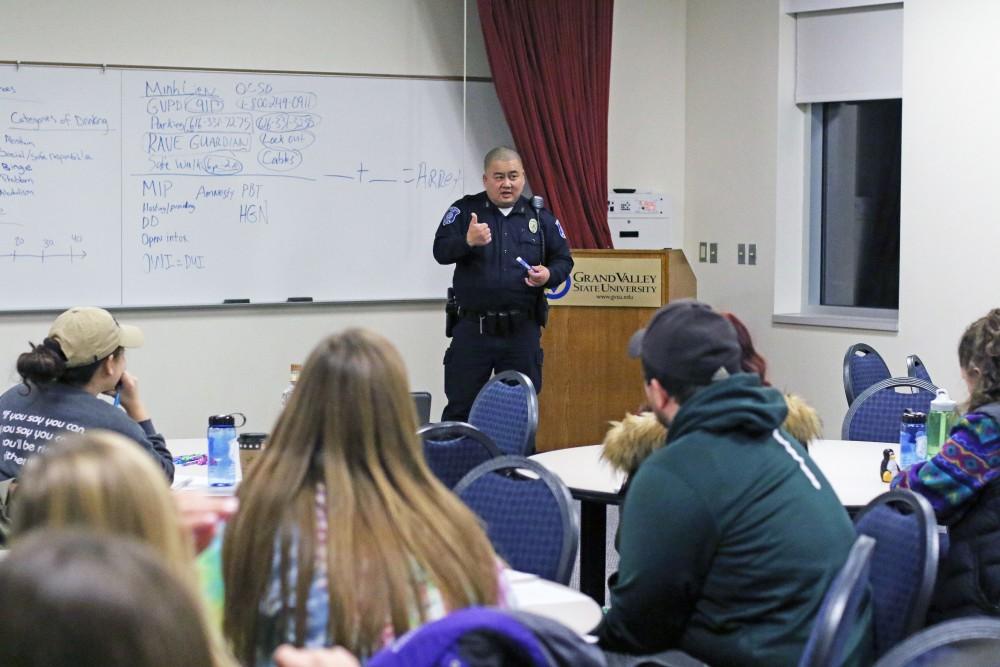Being smart about alcohol

GVL / Emily Frye Grand Valley’s Officer Min teaches a group of students about being safe with substances on Wednesday Jan. 25, 2016.
Jan 26, 2017
From vodka to beer to tequila, alcohol is a staple at frat parties and tailgates on college campuses across the U.S. While bonding over red Solo cups might seem like a good idea at the time, too much drinking can lead to MIPs, DUIs and even alcohol poisoning.
Harmful and underage college drinking could be considered a public health problem, as noted on the National Institute on Alcohol Abuse and Alcoholism (NIAAA)’s website, potentially negatively affecting the intellectual and social lives of students.
In order to relay how alcohol and other drugs impact an individual’s health and academic career, Grand Valley State University’s Alcohol & Other Drugs Campus Education Services (ACES) conducted the Alcohol (and Other Drugs): Truth, Lies and Consequences (ATLC) program on the Allendale Campus, Wednesday, Jan. 25, in the Kirkhof Center.
About 20 students attended the event, during which ACES staff members focused on informing the room about making healthier and more informed choices when consuming alcohol.
“Responsible drinking means taking the necessary steps to ensure you are obeying the law and being mindful of the health and safety of yourself and others,” said Renee Freeman, chief of police at GVSU’s police department.
Topics at the ATLC event ranged from the true amount of a standard drink, legal consequences, and alcohol and drug-related resources at GVSU and in the surrounding communities.
Genevieve Steffes, the ACES graduate assistant, was one of the moderators for the ATLC event. Steffes said it was important to understand how alcohol usage impacts a person’s wellness and ability to make safe and responsible decisions versus how binge drinking can lead to negative consequences.
Knowing drinking limits, Steffes said, shouldn’t just be based off of feelings, as alcohol poisoning can start as soon as someone gets sick.
“(Vomiting) is actually the body’s first safety mechanism,” Steffes said. “So, it is really saying ‘OK, too much has gone in. Let’s try to get rid of it before we have to process it.’ That’s typically what we see at 0.10.”
While everyone develops some form of alcohol tolerance, which depends on the frequency of drinking, Steffes said there are some concerns associated with excessive or frequent drinking.
Katrina Rast, the doctoral intern at GVSU’s Counseling Center and one of the moderators at the event, said pacing and the amount of alcohol consumed are key components in understanding one’s limitations.
Referencing the Blood Alcohol Content (BAC) scale throughout the entirety of the event—with blowing a 0.08 or higher meaning the individual is over the legal drinking limit when driving—Rast said going above the legal limit can lead to a variety of issues beyond just alcohol poisoning and passing out.
“50 percent of individuals who reach 0.40 BAC will die,” Rast said. “When you reach 0.50, 100 percent of people can die from alcohol poisoning.”
Thinking more critically about alcohol consumption and the possible consequences of a person’s drinking behavior, Rast said to avoid negative consequences, one must make smart and knowledgeable decisions when drinking.
“We’re on a college campus—you’re likely to run into alcohol,” Rast said. “The purpose here isn’t to shame or to preach or to try to tell you to not drink alcohol. It’s really just to educate about safe and responsible drinking habits.”
For more information about ACES and its programs at GVSU, visit https://www.gvsu.edu/aces/.

























